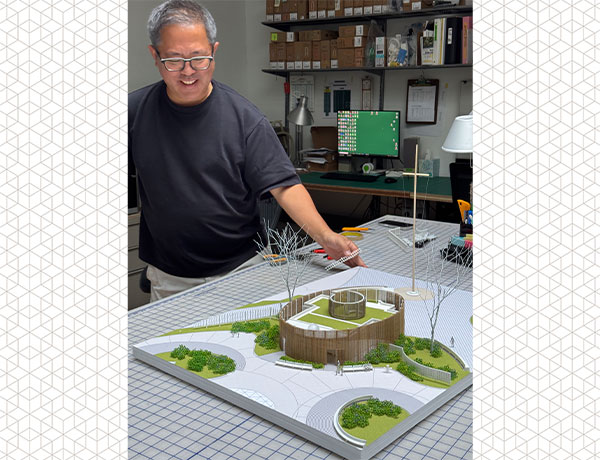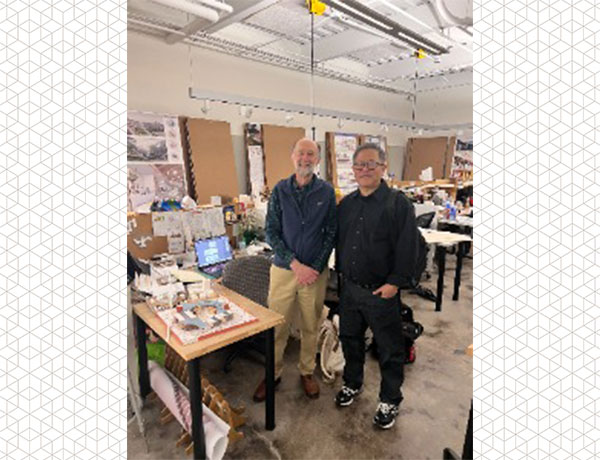

When Nobuhiko Arai arrived at the University of Hartford, architecture was simply an interest. But the foundation he found at UHart turned that spark into a career spanning continents, award-winning projects, and a mission-driven approach to design that continues to evolve. Twenty-five years later, Arai returned to campus to connect with Department Chair Jim Fuller and view student work at the spring 2025 CETA Design Expo.
Arai, who earned his Bachelor of Science in Architecture in 2000, credits the University of Hartford for awakening his passion. “UHart introduced me to architecture and showed me how a small interest in school can become a passion and a career,” he reflects. That early exposure didn’t just shape his technical knowledge; it also instilled a mindset. “The school environment helped me understand the significance of building connections and interacting with diverse individuals. I learned to believe in my ability to tackle challenges and navigate unfamiliar situations.”
After completing his master’s degree at the New Jersey Institute of Technology, Arai faced the common but daunting early-career challenge: landing that first job. Without much experience or a professional network, he went to more than eight interviews before securing a role at a small five-person architecture firm in Elizabeth, New Jersey. There, he designed strip malls and masonry office buildings while honing a work ethic that would shape his career.
“I asked my boss if I could try creating 3D renderings for clients in my free time,” he recalls. The renderings impressed both his boss and the clients, and the initiative set the tone for Arai’s career: always seeking to do more and do it better.
He supplemented his professional work by entering design competitions, sometimes reaching the final rounds in major international contests. These early experiences taught him the value of creativity, perseverance, and collaboration.
A turning point came when a friend connected Arai with STV Inc. in New York City. Working in New York had long been a dream, and Arai embraced every opportunity. He created construction documents for infrastructure and education projects and continued to design, often staying late to refine his ideas. He even pinned posters of his work in his cubicle to stay motivated.
Soon after, Arai was invited to join a new aviation architecture group led by Robert Davidson, former chief architect for the Port Authority of New York. Davidson, a survivor and leader of the World Trade Center rebuilding effort, became a powerful mentor. “Working with him was tough but inspiring. He taught me to trust the process and told us we could achieve great things,” Arai says.
Under Davidson’s leadership, Arai collaborated with major firms like KPF and SOM, contributing to significant public projects, including the design phase of Moynihan Station. His reputation grew—as did his ambitions.
Nobuhiko Arai '00, ArchitectureUHart introduced me to architecture and showed me how a small interest in school can become a passion and a career. The school environment helped me understand the significance of building connections and interacting with diverse individuals. I learned to believe in my ability to tackle challenges and navigate unfamiliar situations.
- Museum of the Built Environment
- International Design Awards, Gold Award
- Bilkent Erzurum Laboratory School
- Society of American Registered Architects, National Design Award
- The Forge
- American Institute of Architects-Brooklyn + Queens, Design Award
- SUNY Purchase Center for Media, Film, and Theatre
- AIA Tri-State Design Awards, Honor Award, Architecture
But then came a crossroads. Arai’s work visa was expiring, and he faced the choice of returning to Japan or securing a Green Card. While STV was slow to support the process, another firm, FXCollaborative (then FXFowle), offered both a job and a path to stay. With Davidson’s understanding, Arai made the leap.
At FXCollaborative, he thrived in an international studio of young, creative minds, tackling design competitions worldwide. A highlight was redesigning a mosque in Saudi Arabia overnight after the client rejected the initial concept. The client loved Arai’s version, and the project later won the Chicago Athenaeum International Architecture Award, being named one of the top five modern mosques in the world.
His portfolio grew to include award-winning projects such as Columbia University’s Business School (with Diller Scofidio + Renfro), the Museum of the Built Environment, and The Forge. Each project reflected his drive to combine aesthetic excellence with community value.
Arai later moved to AECOM to launch a design studio with a former colleague. There, he worked on a high-profile entrance redesign for Penn Station in New York and placed second in a major train station competition in China.
Yet after years at large firms, Arai sought something more personal and impactful. He joined WXY Studio, a smaller firm known for its community-driven, sustainability-focused work. His first WXY project? Designing a Brooklyn school addition using cross-laminated timber, one of the first such constructions in New York City. It was a full-circle moment: blending design, environmental consciousness, and community investment.
More recently, he has joined the Design for Freedom initiative, working to remove forced labor from building material supply chains and advocating for ethical architecture. “Hopefully, we will be successful and establish new standards for future projects,” he says.
Arai’s advice to students? “Put your feet in the river. Get involved, try things, and let the current of experience guide you.” Architecture, he emphasizes, demands both vision and versatility, and when done with care, it transforms not just skylines but lives.